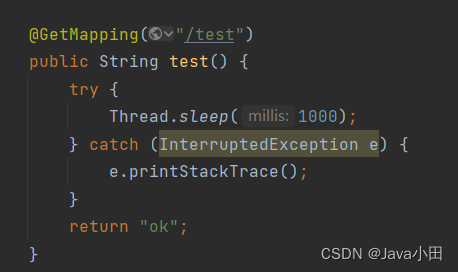-
httpClient同步、异步性能对比
0、测试目的
同步阻塞模式下,如果服务端接口响应较慢,那会直接影响客户端接口请求的吞吐量,虽然可以通过在应用代码中通过异步线程的方式优化,但是会增加客户端的线程开销。所以考虑用异步模式来解决这个问题
因此测试时,主要是针对线程数设置比较小的情况下,客户端发起请求的吞吐量来进行对比
1、准备工作
用spring boot写一个最简单的接口:sleep 1s,然后返回ok

客户端程序引入httpClient依赖:
org.apache.httpcomponents.client5 httpclient5 5.1.3 - 1
- 2
- 3
- 4
- 5
2、同步模式
代码:
import lombok.SneakyThrows; import org.apache.hc.client5.http.ClientProtocolException; import org.apache.hc.client5.http.classic.methods.HttpGet; import org.apache.hc.client5.http.impl.classic.CloseableHttpClient; import org.apache.hc.client5.http.impl.classic.HttpClients; import org.apache.hc.client5.http.impl.io.PoolingHttpClientConnectionManager; import org.apache.hc.core5.http.ClassicHttpResponse; import org.apache.hc.core5.http.HttpEntity; import org.apache.hc.core5.http.HttpStatus; import org.apache.hc.core5.http.ParseException; import org.apache.hc.core5.http.io.HttpClientResponseHandler; import org.apache.hc.core5.http.io.entity.EntityUtils; import java.io.IOException; import java.util.concurrent.atomic.AtomicBoolean; import java.util.concurrent.atomic.AtomicInteger; public class SyncClientHttpTest { static final CloseableHttpClient httpclient; static { PoolingHttpClientConnectionManager connectionManager = new PoolingHttpClientConnectionManager(); connectionManager.setMaxTotal(1000); connectionManager.setDefaultMaxPerRoute(100); httpclient = HttpClients.custom().setConnectionManager(connectionManager).build(); } public static void main(final String[] args) throws Exception { AtomicInteger atomicInteger = new AtomicInteger(0); AtomicBoolean stop = new AtomicBoolean(false); for (int i = 0; i < 10; i++) { new Thread(() -> { while (!stop.get()) { httpGet(); atomicInteger.incrementAndGet(); } }).start(); } Thread.sleep(30000); stop.set(true); Thread.sleep(1000); System.out.println(atomicInteger.get()); System.exit(0); } @SneakyThrows private static void httpGet() { final HttpGet httpget = new HttpGet("http://localhost:8080/test"); // Create a custom response handler final HttpClientResponseHandler<String> responseHandler = new HttpClientResponseHandler<String>() { @Override public String handleResponse( final ClassicHttpResponse response) throws IOException { final int status = response.getCode(); if (status >= HttpStatus.SC_SUCCESS && status < HttpStatus.SC_REDIRECTION) { final HttpEntity entity = response.getEntity(); try { return entity != null ? EntityUtils.toString(entity) : null; } catch (final ParseException ex) { throw new ClientProtocolException(ex); } } else { throw new ClientProtocolException("Unexpected response status: " + status); } } }; final String responseBody = httpclient.execute(httpget, responseHandler); // System.out.println(responseBody); if(!responseBody.equals("ok")) { throw new RuntimeException("error"); } } } }- 1
- 2
- 3
- 4
- 5
- 6
- 7
- 8
- 9
- 10
- 11
- 12
- 13
- 14
- 15
- 16
- 17
- 18
- 19
- 20
- 21
- 22
- 23
- 24
- 25
- 26
- 27
- 28
- 29
- 30
- 31
- 32
- 33
- 34
- 35
- 36
- 37
- 38
- 39
- 40
- 41
- 42
- 43
- 44
- 45
- 46
- 47
- 48
- 49
- 50
- 51
- 52
- 53
- 54
- 55
- 56
- 57
- 58
- 59
- 60
- 61
- 62
- 63
- 64
- 65
- 66
- 67
- 68
- 69
- 70
- 71
- 72
- 73
- 74
- 75
- 76
- 77
- 78
- 79
- 80
- 81
- 82
- 83
- 84
- 85
- 86
- 87
- 88
- 89
开启5个线程,循环发起请求30s
打印结果:150
差不多每秒5个请求,符合预期改为10个线程
打印结果:300改为100个线程
打印结果:3000请求吞吐和线程数呈线性增长关系(线程数应小于maxPerRoute)
3、异步模式
代码:
import lombok.SneakyThrows; import org.apache.hc.client5.http.async.methods.*; import org.apache.hc.client5.http.impl.async.CloseableHttpAsyncClient; import org.apache.hc.client5.http.impl.async.HttpAsyncClients; import org.apache.hc.client5.http.impl.nio.PoolingAsyncClientConnectionManager; import org.apache.hc.core5.concurrent.FutureCallback; import org.apache.hc.core5.reactor.IOReactorConfig; import org.apache.hc.core5.util.Timeout; import java.util.concurrent.Future; import java.util.concurrent.atomic.AtomicBoolean; import java.util.concurrent.atomic.AtomicInteger; /** * Example of asynchronous HTTP/1.1 request execution. */ public class AsyncClientHttpTest { static final CloseableHttpAsyncClient client; static final AtomicInteger atomicInteger = new AtomicInteger(0); static final AtomicBoolean stop = new AtomicBoolean(false); static { PoolingAsyncClientConnectionManager connectionManager = new PoolingAsyncClientConnectionManager(); connectionManager.setMaxTotal(1000); connectionManager.setDefaultMaxPerRoute(100); IOReactorConfig ioReactorConfig = IOReactorConfig.custom() .setSoTimeout(Timeout.ofSeconds(5)) .setIoThreadCount(5) //IO线程数 .build(); client = HttpAsyncClients.custom() .setIOReactorConfig(ioReactorConfig) .setConnectionManager(connectionManager) .build(); client.start(); } public static void main(final String[] args) throws Exception { new Thread(()->{ while (!stop.get()) { httpGet(); } }).start(); Thread.sleep(5000); stop.set(true); Thread.sleep(25000); System.out.println(atomicInteger.get()); // client.close(CloseMode.GRACEFUL); System.exit(0); } @SneakyThrows private static void httpGet() { final SimpleHttpRequest request = SimpleRequestBuilder.get() .setUri("http://localhost:8080//test") .build(); final Future<SimpleHttpResponse> future = client.execute( SimpleRequestProducer.create(request), SimpleResponseConsumer.create(), new FutureCallback<SimpleHttpResponse>() { @Override public void completed(final SimpleHttpResponse response) { // System.out.println(request + "->" + new StatusLine(response)); // System.out.println(response.getBody().getBodyText()); if(!response.getBody().getBodyText().equals("ok")) { throw new RuntimeException("error"); } atomicInteger.incrementAndGet(); } @Override public void failed(final Exception ex) { System.out.println(request + "->" + ex); } @Override public void cancelled() { System.out.println(request + " cancelled"); } }); } }- 1
- 2
- 3
- 4
- 5
- 6
- 7
- 8
- 9
- 10
- 11
- 12
- 13
- 14
- 15
- 16
- 17
- 18
- 19
- 20
- 21
- 22
- 23
- 24
- 25
- 26
- 27
- 28
- 29
- 30
- 31
- 32
- 33
- 34
- 35
- 36
- 37
- 38
- 39
- 40
- 41
- 42
- 43
- 44
- 45
- 46
- 47
- 48
- 49
- 50
- 51
- 52
- 53
- 54
- 55
- 56
- 57
- 58
- 59
- 60
- 61
- 62
- 63
- 64
- 65
- 66
- 67
- 68
- 69
- 70
- 71
- 72
- 73
- 74
- 75
- 76
- 77
- 78
- 79
- 80
- 81
- 82
- 83
- 84
- 85
- 86
- 87
- 88
- 89
- 90
- 91
- 92
- 93
- 94
- 95
- 96
ps: 这里代码其实不够严谨,不过测试结果对比已经很悬殊了,不影响最终结论
开启5个IO线程(不设置默认为cpu核数)
客户端1个线程循环发起请求5s,之后再sleep 25s打印结果打印结果:2700
修改代码:connectionManager.setDefaultMaxPerRoute(100);
->connectionManager.setDefaultMaxPerRoute(200);
调大maxPerRoute为200打印结果:5400
可以看到异步模式下,每秒的吞吐受maxPerRoute的影响较大(基本持平)
注意如果不手动设置,这个默认值为5,所以如果不进行ConnectionManager设置,异步的测试结果会很差3、结论
异步模式下因为使用了多路复用,一个IO线程管理多个连接,所以只需少量线程即可进行大量的远程接口调用
-
相关阅读:
【Java 基础篇】Java transient 关键字详解:对象序列化与非序列化字段
centos7系统安装流程
Docker Hub 镜像代理加速
laravel框架 - 开发实战(目录结构,路由,控制器,模型,视图)
Centos下载安装redis- 使用yum
【无标题】
代码随想录算法训练营第2天| 977有序数组的平方、209长度最小的子数组。
1143. 最长公共子序列(C++实现)
婚恋相亲交友红娘小程序源码开发搭建方法
Spring Data JPA - Web 支持、排序和分页
- 原文地址:https://blog.csdn.net/li281037846/article/details/127683503
